psychology - term 4 🍓
1/67
There's no tags or description
Looks like no tags are added yet.
Name | Mastery | Learn | Test | Matching | Spaced |
|---|
No study sessions yet.
68 Terms
what is culture?
the shared group of rules that govern the behaviour of a group of people and enable members of that group to coexist
what is sociaisation?
the process of learning a society’s culture and learning how to interact with others
what is social psychology?
examination of the way we interact with others, how we behave as part of a group, and what effects other people have on us
what are attitudes?
evaluative (positive or negative) judgements about a particular situation, group of people or subject. Expressed values and convey a person’s identity.
what do attitudes do?
enable us to evaluate objects as good or bad and directly influence actions & behaviours
what is the significance of attitudes?
important for effective communication and interpretation of written and spoken language, social control (political campaigning, health and safety and advertising), drive us to behave in particular ways
what are the 3 components of attitude?
Affective, behavioural, cognitive
what does the ‘affective’ component of attitude mean?
the emotional feelings (hate, happiness, etc)
what does the ‘behavioural’ component of attitude mean?
the actions taken
what does the ‘cognitive’ component of attitude mean?
the beliefs (factual and neutral)
what are implicit attitudes?
are attitudes that are involuntarily formed, unconscious and difficult to self report; implied
what are explicit attitudes?
attitudes that are deliberately formed, conscious and shaped openly
what is cognitive dissonance?
an unpleasant feeling of psychological tension that comes when we perceive that our attitudes are inconsistent with our behaviour
what are the 4 strategies to reduce cognitive dissonance?
changing your behaviour to match your attitude/thoughts, changing your attitude/thoughts to match your behaviour, reduce the importance of the attitude and behaviour, adding new elements to support your behaviour or attitude
what are our initial thoughts about a person based on?
our evaluation of their looks, how they talk, what they are wearing and how they behave
what are stereotypes?
a collection of beliefs held about a person belonging to a particular group, regardless of individual differences between members. Not based on evidence and are often perpetuated by biases
how do stereotypes contribute to the 3 components of attitude?
stereotypes = thoughts and opinions (cognitive), prejudice = feeling, either positive or negative, stereotypes + prejudice = discrimination and bias (behaviour)
what does bias mean?
tendency to prefer one person or thing to another and to favour that person or thing. Simplifications or distortions in judgement or reasoning that affect decision making
what are the two main types of bias?
self-serving bias and confirmation bias
what is self-serving bias?
a tendency to view ourselves in a more positive light; attributing success to ourselves and failing to consider outside or situational factors
what is confirmation bias?
a tendency for people to search for confirmation of what they already believe
what is culture?
the shared beliefs, values, customs behaviours and artifacts that characterise a group of people or a society/
what are examples of key elements of culture?
language, customs, cuisine, ideologies, religious beliefs, values, art, music, literature, clothing/fashion and architecture/housing
in relation to culture, what do people tend to do?
use their own culture’s norms and values to define what is natural and correct
what is a sub-culture?
a smaller, distinct cultural group within a larger culture. Exhibit their own unique customs, values, behaviours, symbols and lifestyles that set them apart from the dominant or mainstream culture
for members of sub-cultures, are their interests, experiences, etc represented in society?
no, not adequately represented/addressed in broader society
what are the 5 ways sub-culture has impacted mainstream society?
challenge norms, cultural innovation, acceptance and influence, initiate political and social movements, influence and change customer trends
how do sub-cultures challenge norms?
offer alternative ways of thinking, living and expressing oneself; provoke thought amongst mainstream society
how do sub-cultures introduce cultural innovation?
create new styles and art forms, music styles, fashion trend and social practices that find their way into mainstream
how do sub-cultures influence mainstream society & gain acceptance?
by youth media, pop culture, etc. They influence broader societal norms and gain acceptance in result
how do subcultures initiate political and social movements?
mobilise for change, make political statements, challenge dominant group
how do sub-cultures change customer trends?
by influencing how people buy and sell
what did the bobo doll experiment (1961) do?
children watched adults behave aggressively towards “bobo doll”, when leave along with the doll, the children acted violently against it
what does the bobo doll experiment reveal?
that we behave through copying others, more likely to imitate models if the models are rewarded.
what did the Milgram experiment (1963) do?
participants were asked to act as a teacher, giving larger shocks to the ‘pupil’ for each wrong answer. '‘Pupil’ could be heard screaming in agony while Migram asked participant to continue to higher volts
what does the milgram experiment reveal?
that people allow others, particularly authority figures, to direct their actions, even if they feel and think it’s wrong of inappropriate. Explains how people can make decisions against their own conscience (ie: participating in war)
what did the stanford prison experiment (1971) do?
set up a mock prison environment and participants were assigned the role of ‘prisoner’ or ‘guard’. 'The ‘guards’ felt powerful and became authoritarian and aggressive, whereas the prisoners felt powerless and became submissive and passive.
what did the stanford prison experiment reveal?
that we all have a tendency to conform to societal roles (in regards to stereotypes such as prisoners and guards) and that social forces have the power to make us do evil things
what is sensation?
the process by which our senses receive information from the outer world
what are our 5 senses? (in relation to psych)
light (vision), sound (hearing), chemicals (taste and smell), touch (tactile perception, pressure, pain, temperature), vestibular/proprioception (kinesthetic, balance and body position)
how do chemical senses work?
taste buds contain receptor molecules that read food molecules and report back to the brain. These receptors send information to the brain’s olfactory bulb, then sends it on the primary smell cortex and parts on the limbic system.
what is the relationship between smell and emotion?
smells are tied with our feelings and memories because smell neural circuity connects to the limbic system. The brain stores and recognises smells via associations (ie: happiness when walking into bakery)
how does our sense of touch work?
skin has million of sensors that sense feelings such as pain, temperature and pressure. Some spots on body are more or less sensitive.
what are the three main sensations of touch?
pain (outnumber other sensors to prevent bodily damage), temperature (heat and cold sensors help you regulate body temp), pressure (respond to contact forces between skin, etc, include sensors attached to hair and skin)
how does our kinesthetic sense work?
deformed sensors send a chemical signal to nerve signals. sense of touch combines with bones, joints, etc sensors to provide personal kinesthesis - the way your body senses its own movement and positioning without relying on other senses.
what is vestibular sense do?
monitors your head’s position and your balance
what does absolute threshold mean?
the minimum amount of stimulus energy needed for an observer to perceive (detect) a stimulus, in ideal conditions, 50% of the time. To receive a sensation, the stimulus energy must reach the sense organ and be at a level sufficient to activate sense receptors.
what is the difference between sensation and perception?
sensation is a bottom-up process by which senses detect or recieve environmental stimuli and relay it to the brain. Meanwhile, perception is a top-down process by which the brain organises and interprets sensory information into something meaningful
what are the 5 stages of visual perception?
reception by accessory structures, transduction by sensory receptors and receptive fields, transmission to the CNS via optic nerve, preliminary processing in the thalamus, organisation and interpretation by the primary visual cortex
what is the 1st stage of visual perception? what happens?
reception by accessory structures (sensation) - light first passes through the cornea, pupil and lens, which allows it be focused onto the retina at the back of the eye. Iris regulates the amount of light entering while the cornea and lens direct and focus the light
what is the 2nd stage of visual perception? what happens?
transduction by sensory receptors and receptive fields (sensation) - In the retina, photoreceptor cells (rods and cones) absorb light energy. This energgy is converted into electrochemical signals.
What is the 3rd stage of visual perception? what happens?
transmission to the CNS via optic nerve (sensation) - signals are passed from photoreceptors to bipolar cells to ganglion cells. Axons of ganglion cells form the optic nerve, which carries neural impulses towards the brain
what is the 4th stage of visual perception? what happens?
preliminary processing in the thalamus (perception) - signals arrive in the thalamus, where information is sorted and relayed according to spatial location, colour and movement
what is the 5th stage of visual perception? what happens?
organisation and interpretation by the primary visual cortex - information is sent to the primary visual cortex in the occipital lobe. Brain ‘makes sense’ of information by using visual perceptual principles, past experiences, values, etc
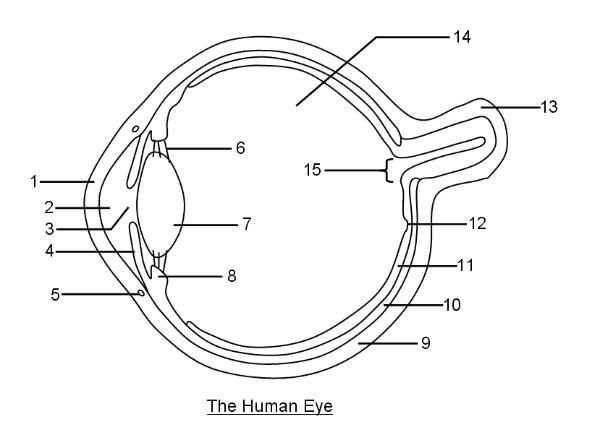
what is number 13?
optic nerve
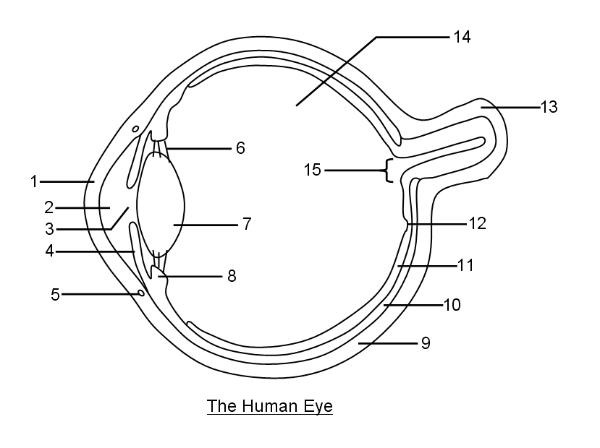
what is number 4?
iris
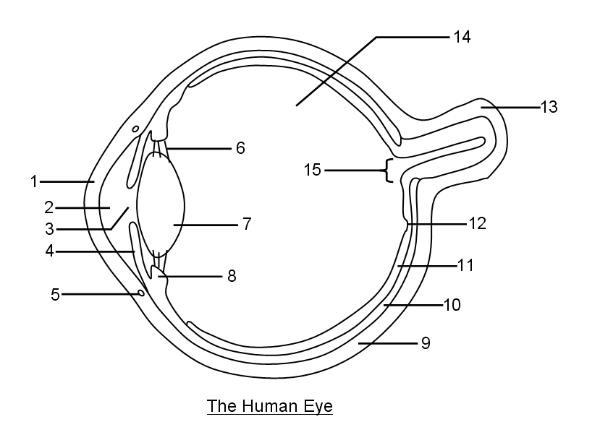
what is number 1?
cornea
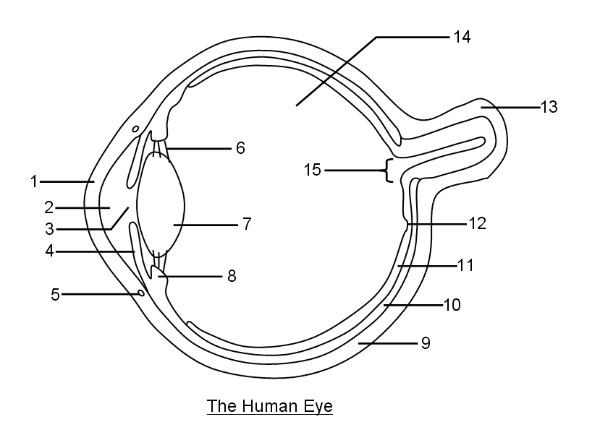
what is number 7?
lens
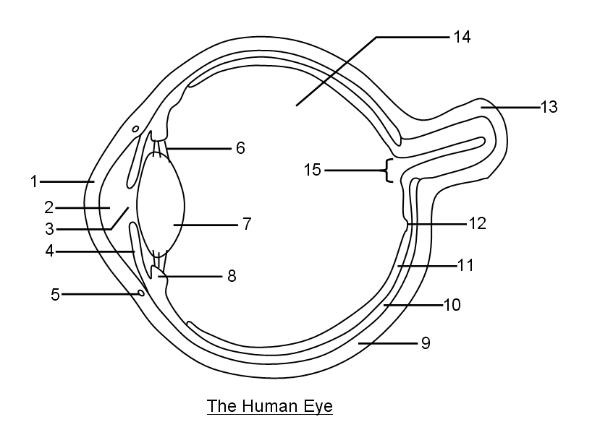
what is number 3?
pupil
what is the cornea?
clear dome-shaped structure that helps focus light rays onto the retina
what does the pupil do?
control how much light enters the eye. In low light, the pupil dilates
what does the lens do?
bends and adjusts the shape of light to focus it on the retina
what is the importance of the retina? where is it?
contains cells that convert light into electrical impulses that are sent to the brain (cones and rods), all around the back of the eye
what does the optic nerve do?
carry electrical impulses from the retina to the brain
what does the iris do?
control the amount of light entering the eye by adjusting the size of the pupil
what are the main key structures of the eye?
cornea, pupil, lens, retina (including rods and cones), optic nerve, iris
what are rods? how many are there?
photoreceptor cells in the retina that are responsible for low-light and night vision. They detect black and white shades when the light is low and lack detail. Approx 125 million.
what are cones? how many are there?
photoreceptor cells in the center retina that enable colour vision and provides us with details. Need bright light to work. Approx 6.5 million.